Studying online is an exciting opportunity and we want to ensure you are familiar with the systems CQUniversity uses to allow you to study smoothly.
The key online Learning Management System used at CQUniversity is Moodle. Within Moodle, you will be able to find content related to your units such as the unit profile, study guide, assessments, tutorial questions and much more!
Keep reading to view the ins and outs of navigating Moodle.
How do I access Moodle?
Moodle can be accessed from the MyCQU Student Portal. In the “Courses and Units” area, click on the picture of the mortarboard which will take you directly to the Moodle page for that unit. Make sure you bookmark the Student Portal on the device you use the most as this is the most efficient way to access our systems.
Alternatively, you can access Moodle directly at moodle.cqu.edu.au which takes you to the Moodle Dashboard.

Direct me to the Dashboard!
Moodle has a range of features that allow you to study effectively. Recently Moodle was upgraded. New Dashboard features include the Nav Drawer, Notifications, Messages, Show/Hide Blocks and the Quicklinks menu.
The dashboard is essentially your Moodle home page where you can navigate to your units. Jump on and get familiar!
Finding things in Moodle
You will use Moodle to access each of your units and all of the key content you require for your course. Once you are on your unit page, it may look something like this.

It is up to your unit coordinator to design your unit’s page so section names may be by topic/week. Make sure you explore all sections of each unit of Moodle. Get familiar with all the content!
On your unit page, you can click the Section name to show or hide the section. Blocks are located on the left and right hand side of your units. Click the green and white square to dock/undock the blocks. Moodle has a range of capabilities and different types of resources and information in your unit under each of these sections. Some different content that may be on your Moodle page include:
Forums –
Forums are a powerful communication tool within a Moodle course. Think of them as online message boards where you can post messages to each other while easily keeping track of individual conversations. Forums are the primary tool for online discussion. We recommend checking these at least a few times a week, even daily.
Files –
The File resource type allows you to access files such as a Word documents, PowerPoints, PDFs etc. It allows you to display and download a variety of resources from your unit. The files in your unit will appear with a different icon depending on their type.
URL –
A URL is a link on the internet to a website or online file. A URL resource is often used to provide students with web links for research, saving the student time and effort in manually typing out the address.
Pages –
A page resource creates a link to a screen that displays the content created by the teacher.
Echo360 video – Echo360 is the main video platform used for teaching at CQUni. Recorded lectures or tutorials may be uploaded to your unit.
Zoom –
Zoom video conferencing is a cloud-based video conferencing and online meeting platform, CQUniversity uses Zoom as the platform to interact with students in real-time.
Once you have viewed the above content, you can “Mark as Complete” by ticking the grey box to the right of the resource if enabled.
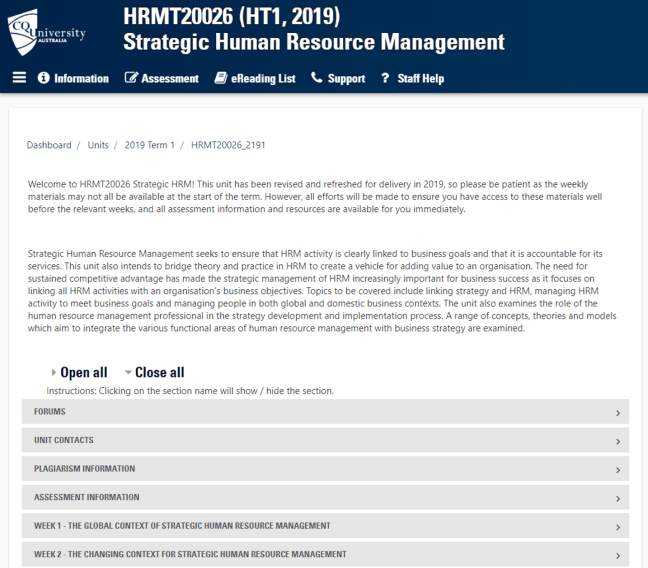
Forum Preferences
If you’re enrolled in a unit, you’re automatically subscribed to the forums for that unit. This is the same for course-level Moodle sites like Nursing Central and can result in hundreds of Moodle forum emails throughout the term.
Good news! You can alter this subscription to a daily digest and alter your preferences for forum conversations. To do so, find your Moodle Profile in the top corner of the page and select ‘Preferences’. From here, select ‘Forum Preferences’ and adjust your settings.
Assessment Submission
Submitting an assessment is probably one of the most important tasks you undertake on Moodle.
Information regarding your assessment such as criteria, marking rubric and resources will be on your Moodle unit page. On the left-hand side of Moodle, you will notice a block called Assessments. Links to assessments will appear here or under the section headings. The two main assessment types are online submissions and quizzes.
To upload your assignment, click on the assessment submission area. You can recognise this by the icon of a hand holding a piece of paper. Click the Add Submission Button. Click the “Add” button to choose which file to upload or drag and drop the file into the dotted section.
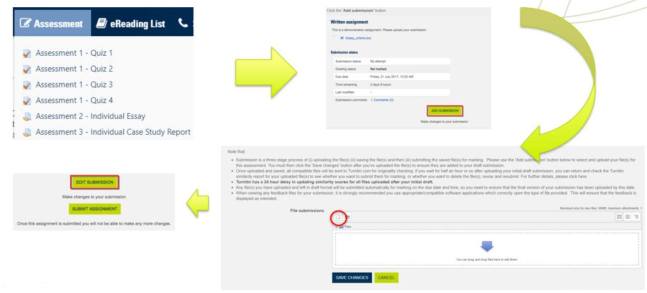
Please read the “Note that” section which explains the next steps after uploading the file or refer to Moodle help for students for a more detailed description. Click Save Changes. You can now Edit your Submission or click Submit Assignment. Once the assignment is submitted you will not be able to make any changes.
Once you’ve declared that the work is your own, you’ll now see that your assessment file has been successfully submitted for marking and you can no longer make changes to the file/s or your submission. And you will receive an automated email confirming that your assignment has been submitted.
YES! You have now officially ticked off one assessment, pat yourself on the back. Make sure you proofread your assessment before submitting and once it has been graded, read ALL the feedback.
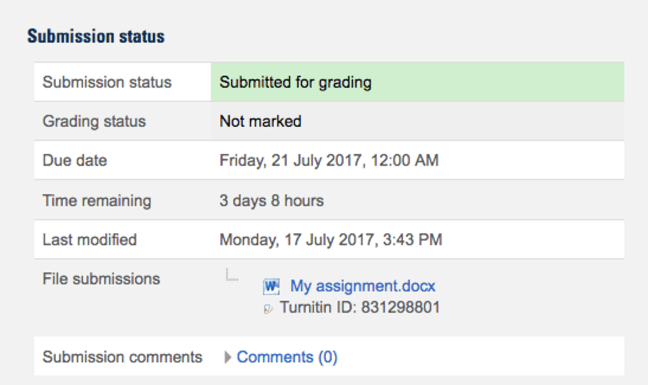
Turnitin
When you submit an assignment, it will be run through Turnitin. Turnitin is a text matching software.
Once you upload an assessment in Moodle your paper will be queued in Turnitin and a ‘Similarity Score’ will be generated in a reasonably short time. Your Turnitin ‘Similarity Score’ is a learning tool that allows you to submit your paper as a draft, and then check the ‘Similarity Score’ report to ensure you have included all your references.
Your score is colour coded to visually represent the amount of matched text found. There is no “acceptable score” it is simply an indication of matching text, which should be checked to ensure you have correctly cited and referenced all the sources used in your paper.
Once your Turnitin ‘Similarity Score’ report has been generated, you can view it from your Moodle assignment submission page. Clicking on the percentage score icon will take you into Feedback Studio, where you can then view your ‘Similarity Score’. Look at the image which explains the elements of your Turnitin Similarity Score:
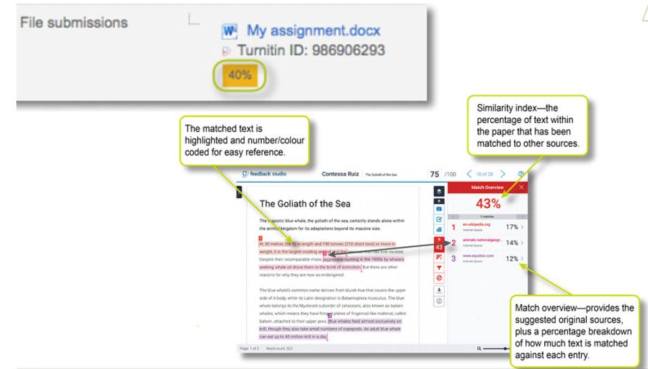
Quizzes, quizzes, quizzes
Some units will require you to undertake a quiz. The quiz icon looks like a piece of paper with a red tick. You can access these via the Assessment block or sections.
There are different types of quizzes and questions including timed quizzes, highest attempt, free text questions and multiple choice. Ensure you pay attention to the grading method, attempts allowed and time limit before attempting. To start a quiz, Click Attempt Quiz Now.
The question page will now appear, answer each question. Please note that you may have to click the “Next” button if the quiz contains multiple pages. Once completed, click Submit all and finish. Depending on the options selected by your unit coordinator, you may be able to see only your overall marks, or you may see your mark and be able to review your attempt and see the correct answers. For more information on Quizzes, go to Moodle Help for Students.
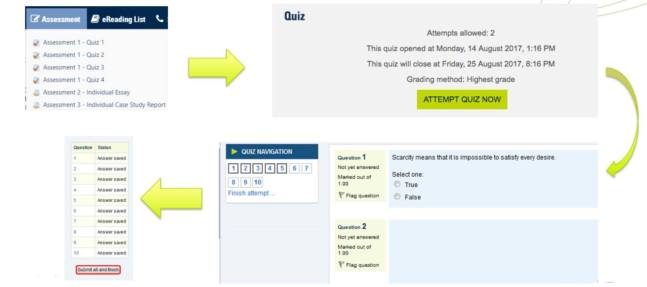
Let me see them GRADES
A summary is available for assessment grades. To access this, visit the Administration tab in Moodle and select ‘Grades’.
From this page, you can view grades as both a number and a percentage. The percentage value can be helpful when calculating your overall unit grade before Certification of Grades. Once published, an overall unit grade is also available from the Profile section mentioned above.
Help…I need an Extension
The Assessment Extension Request is available from the Support block in Moodle. Have your supporting documentation and the length of time you are requesting ready when you open the extension request.
Other Moodle Units
You can also access certain support services via Moodle such as Countdown to CQUni (Orientation Online), First Year Hangout, Peer Assisted Study Sessions and ALC! To view these, search for them in the search box or visit the Student Portal.
Support
Moodle is an extremely effective system that streamlines online study. If you require more support or assistance visit the Moodle Help for Students section of the Support block. You can also find your unit contacts in the information block of every unit.
For technical assistance, the Technology and Services Assistance Centre (TaSAC) can be contacted on 1300 666 620 or email [email protected]. More information on opening hours can be found on the Student Portal – I.T. Support section.
HAPPY ONLINE STUDYING!